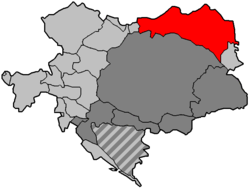Queen of Lodomeria
| Kingdom of Galicia and Lodomeria | ||||||||||||||||||||
|
Królestwo Galicji i Lodomerii (Polish) Königreich Galizien und Lodomerien (German) Королівство Галичини та Володимирії (Ukrainian) |
||||||||||||||||||||
| Crown land of the Habsburg Monarchy (1772–1804), of the Austrian Empire (1804–67), and of the Cisleithanian part of Austria-Hungary (1867–1918) | ||||||||||||||||||||
|
||||||||||||||||||||
|
||||||||||||||||||||
|
Galicia and Lodomeria in Austria-Hungary in 1914
|
||||||||||||||||||||
|
Annexed from the Polish–Lithuanian Commonwealth in 1772, following the First Partition of Poland
|
||||||||||||||||||||
| Capital | Lemberg (Polish: Lwów) | |||||||||||||||||||
| Languages |
Official language: German Language of government (since 1867): Polish Minority language: Ruthenian By census 1910: Polish 58.6% Ruthenian 40.2% |
|||||||||||||||||||
| Religion | ||||||||||||||||||||
| Government | Monarchy | |||||||||||||||||||
| Monarch | ||||||||||||||||||||
| • | 1772–1780 | Maria Theresa (first) | ||||||||||||||||||
| • | 1916–1918 | Charles I (last) | ||||||||||||||||||
| Governor | ||||||||||||||||||||
| • | 1772–1774 | Johann von Persen (first) | ||||||||||||||||||
| • | 1917–1918 | Karl Georg Huyn (last) | ||||||||||||||||||
| Legislature | Diet | |||||||||||||||||||
| History | ||||||||||||||||||||
| • | Partition | August 5, 1772 | ||||||||||||||||||
| • | West Ukraine | October 19, 1918 | ||||||||||||||||||
| • | Republic of Poland | November 14, 1918 | ||||||||||||||||||
| • | Treaty of St-Germain | September 10, 1919 | ||||||||||||||||||
| Currency | ||||||||||||||||||||
|
||||||||||||||||||||
| Today part of |
|
|||||||||||||||||||
The Kingdom of Galicia and Lodomeria, also known as Galicia or Austrian Poland, became a crownland of the Habsburg Monarchy as a result of the First Partition of Poland in 1772, when it became a Kingdom under Habsburg rule. From 1804 to 1918 it was a crownland of the Austrian Empire. After the reforms of 1867, it became an ethnic Pole-administered autonomous unit under the Austrian crown. The country was carved from the entire south-western part of the Polish–Lithuanian Commonwealth. Among the many ceremonial titles of the princes of Hungary was "ruler of Galicia and Lodomeria".
The name "Galicia" is the Latinized form of Halych, a principality of the medieval Ruthenia. "Lodomeria", is also a Latinized form of Volodymyr-Volynsky that was founded in the 10th century by Vladimir the Great and until the partitions of Poland was known simply as Volodymyr (Polish: Włodzimierz). King of Galicia and Lodomeria was a medieval title which the King of Hungary (Andrew II) adopted during his conquest of the region back in the 12th century.
This historical region in Eastern Europe is divided today between Poland and Ukraine. The nucleus of historic Galicia consists of the modern Lviv, Ternopil, and Ivano-Frankivsk regions of western Ukraine.
...
Wikipedia





